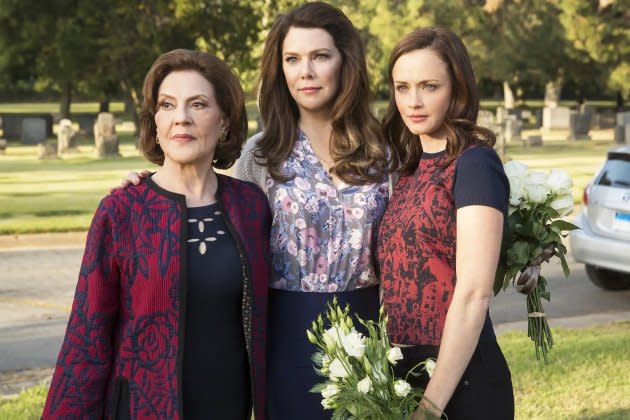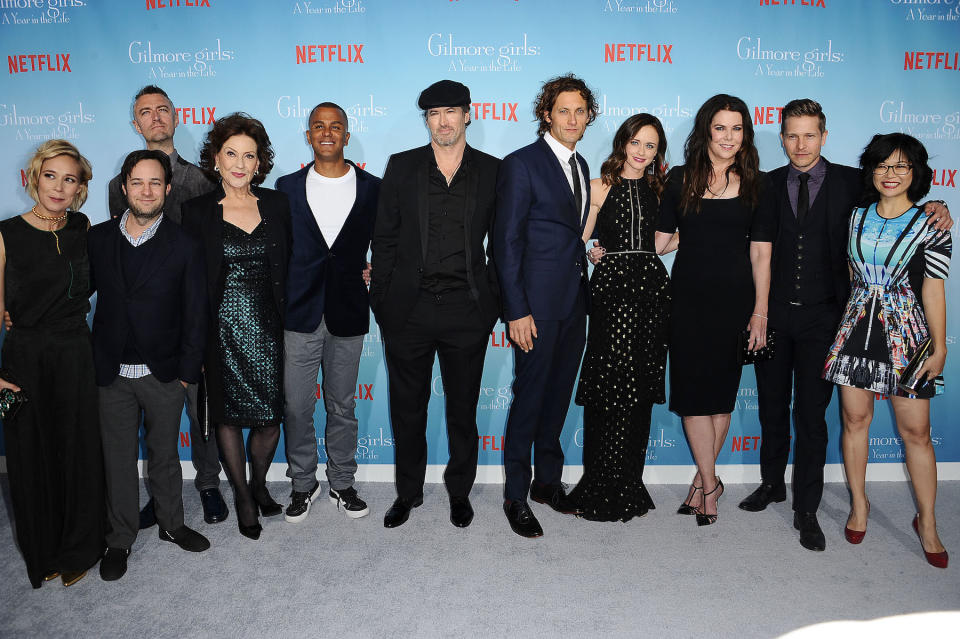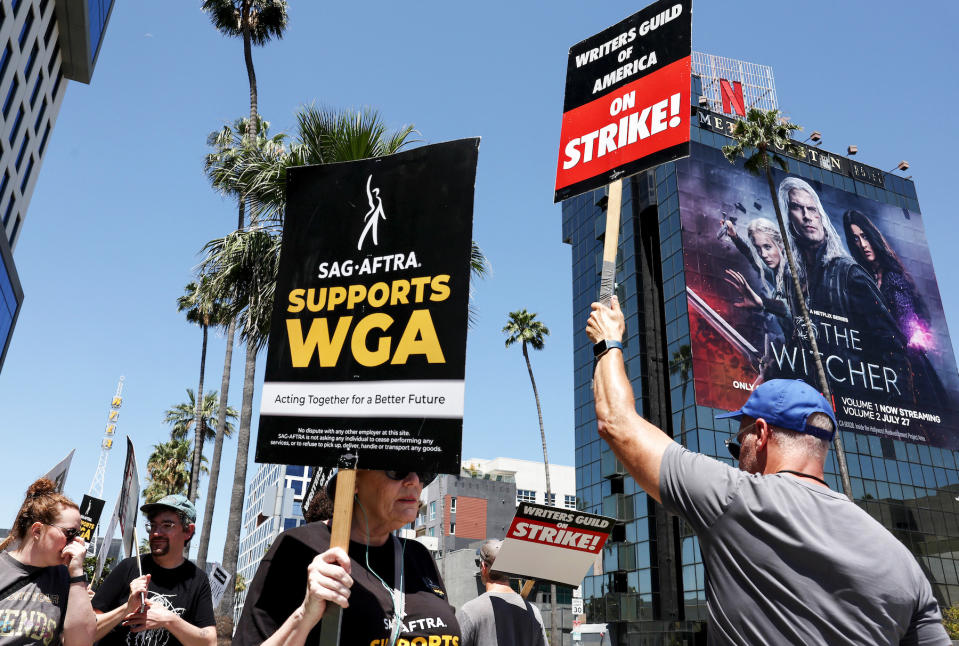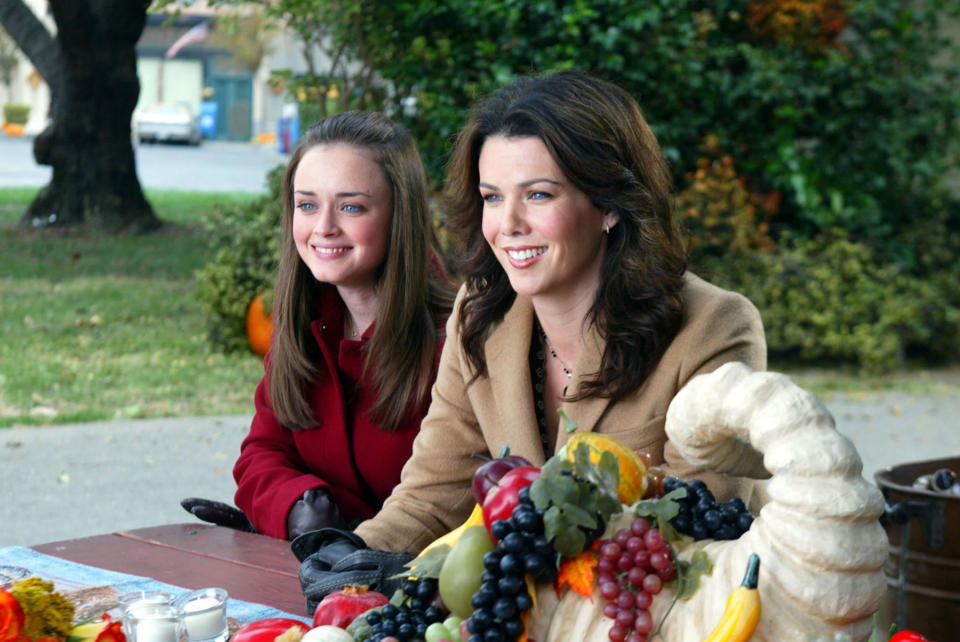‘Gilmore Girls’ Actors Sound Off on Netflix Over Show’s Streaming Residuals
- Oops!Something went wrong.Please try again later.
- Oops!Something went wrong.Please try again later.
- Oops!Something went wrong.Please try again later.

When Gilmore Girls originally aired on The WB then later The CW from 2000 until 2007, the show was popular with audiences. But when the series started streaming on Netflix in 2014, its relevance skyrocketed and awakened a massive fandom, ultimately leading to the show’s 2016 revival Gilmore Girls: A Year in the Life, which streams exclusively on Netflix. Viewers who already knew and loved the show, starring Alexis Bledel as Rory and Lauren Graham as Lorelai, were able to immerse themselves even deeper in the fictional world of Stars Hollow by creating memes, GIFs, and screengrabs while dissecting every detail of their beloved series. New audiences were also able to discover Gilmore Girls for the first time, thanks to the accessibility of streaming.
Netflix undeniably propelled Gilmore Girls to another level of acclaim, but actors who appeared on the show say they don’t feel fairly compensated for their work since it hit the streaming platform. While the actors receive residual checks for appearing on the original Warner Bros. show when it aired on network television, they told Rolling Stone they don’t feel like actors’ current contract with streamers fairly reflects what they should be paid in an instance like this one.
More from Rolling Stone
Ed Sheeran Warns Against AI: 'Have You Not See the Movies Where They Kill Us All?'
Steven Soderbergh Talks Helping Christopher Nolan and Eating the Rich
What My Nude Body Double Taught Me About Myself (and Dating Apps)
“I think Gilmore Girls was sort of the perfect example of the type of show that has been disrespected by the new model,” Sean Gunn, who plays the role of Kirk in Gilmore Girls, tells Rolling Stone. “We had a show that was a modest hit when it was on the air but certainly was not thought of as one of the bigger shows on television. It had a pretty decent life in DVD sales and we were pretty well compensated for that, but when it started streaming in 2014 it really became a massive hit.”
Back in July, Gunn spoke to The Hollywood Reporter while picketing outside of Netflix’s offices in Hollywood. He joined a chorus of other actors who have been discussing the topic of residuals in light of the dual WGA and SAG strikes. According to Gunn, actors do receive “a very small percentage” of the licensing fee that Netflix paid to Warner Bros. for the rights to stream Gilmore Girls, but as many others have pointed out during the strike, the residual fee for streamers is way less than actors were used to getting paid when shows aired on network TV.
“They pay this small fee to lots of shows and throw everything at the wall and see what sticks. Gilmore became this runaway hit for them and we don’t share in any of that success,” Gunn says. “It’s cool that there are new fans and I’m glad that they’re seeing work that I’m proud of but we’re not getting any of the monetary benefit from that.”

Since Netflix doesn’t release their viewership data to the public and “is so secretive about their numbers,” Gunn explains, it’s a mystery just how big of a hit Gilmore Girls is. The actor, who also plays the role of Kraglin Obfonteri in the Marvel Cinematic Universe, said the lack of transparency makes it difficult for him to trust Netflix. Despite not knowing the exact number of total viewers Netflix brought to the series, Gunn says he went from being “occasionally recognized” by fans to always being recognized everywhere he went at all times.
“I just think it’s wrong for us to not know how many units there have been of the product that they’re selling,” he says. “If I have two shows on Netflix, Netflix thinks it’s fine for me to not know which one of them performs better than the other. That’s just wrong from a business perspective.”
In addition to receiving residuals for the original series, the actors say they also receive separate residuals for Netflix’s Gilmore Girls: A Year in the Life revival. Gunn says the residuals for the reboot are “absurdly low for them to just keep the series on their platform and let as many users want to use it as many times as they want.”
When Keiko Agena was cast in Gilmore Girls as Lane Kim, Rory’s best friend, it was her first acting role that was big enough to allow her to quit her day job. Agena also felt the shift in Gilmore’s popularity once it reached a wider audience on Netflix in 2014.
“Before streaming, people knew about the show but I don’t think public awareness was as great as it is now. That’s what hopefully can happen with a good show,” Agena tells Rolling Stone. “And yet there are heartbreaking stories I’ve heard from other people about how you can be on a well-respected show and not be able to make rent and not be able to afford to keep doing what you love to do because it’s just not paying enough money to live.”
Agena thinks it’s ironic Gilmore Girls originally aired on a smaller network compared to Netflix, but the money she’s made in residuals from her original deal “far outpaces” anything she’s made as a result of the show going to a streaming service.
“It’s already very difficult to survive as an actor but I think there’s no way to survive as an actor without the residuals,” she offers. “When I say ‘survive as an actor’ I mean not need to have a second job, to have this be your only career and you’re not doing other things to support yourself.”
Agena has gone on to appear in shows like Better Call Saul, The Prodigal Son, 13 Reasons Why, and Dirty John. The actor explains that her residuals change depending on where they’re coming from and she’s grateful she’s had experiences working on network shows in addition to streaming because of this very reason.
“If as an actor, a person has only worked on streaming shows, that’s really hard. I can’t actually imagine how to make that work,” she says.
Like the other actors, Agena claims she does receive residuals from Gilmore Girls but if her residuals reflected a fair deal based on the number of viewers who have tuned in on Netflix, those checks would look a lot different than they do.
“It would have definitely made a difference in my mailbox,” she says.
Alan Loayza, who plays Rory’s Yale friend and Life and Death Brigade member Colin McCrae, says he saw a change in fans’ interest in him and the show “overnight” when Gilmore Girls began streaming on Netflix. Loayza echoes Gunn’s sentiments about being frustrated by Netflix’s lack of transparency and how the actors will never have a real sense of the viewership numbers.
“The thing with Gilmore Girls, specifically, is it has this special place in a lot of people’s hearts, it’s like one of their family members,” he says. “They turn it on all day because it feels safe to hear the same joke over and over again. It’s comforting to them. To be a part of that and not know just how many people are actually watching doesn’t feel right.”
Before streaming, Loayza maintains working actors were able to make a living, buy houses, and support their families knowing residual checks were guaranteed based on their roles. He doesn’t think that’s the case any longer because of the new media contracts actors have with streamers. While he says he only guest-starred in about 15 Gilmore Girls episodes and didn’t expect to make a full living off this one show alone, Loayza wishes the spike in viewers caused by Netflix was reflected in the residual checks he receives.
“I just always kind of accepted the fact that I would receive a small amount of residuals, but I never had a concept of what that could possibly mean if the show became a cultural phenomenon like it has,” Loayza says. “For me, I understand that if this show had this same popularity maybe 15 years or 20 years earlier on network TV I’d probably be doing a lot better. But since it became popular on a streaming service, I’m not seeing financial gain for this newfound popularity. None of us are.”

John Cabrera, who played Brian Fuller, one of Lane’s bandmates in their local musical group Hep Alien, says when Gilmore Girls was on the air in the 2000s he never thought about his role on a historic show, the fandom, or Gilmore Girls’ potential lasting legacy. It was the popularity brought on by Netflix that made him aware of just how many people watched and loved the show, but he and other cast members noticed a stark contrast in how many viewers seemed to be watching Gilmore Girls and how little money the cast was making from it.
“Suddenly I was somebody. I was a part of a royal family: I was part of this Gilmore Girls ensemble that was known. The irony is, you could feel that the streaming numbers had to be massive, but we were all like, ‘Have you seen any money from it?’ and there was a resounding, ‘No,’” Cabrera tells Rolling Stone.
It was disappointing not to receive residuals that felt fair as a response to Gilmore’s rise on Netflix, especially for Cabrera, who wasn’t a lead in any other shows and says he depends on residuals to keep him going.
“Residuals were a big part of my income, they were part of how I was able to live between acting gigs,” he says. “That is a real thing for actors. Residuals are how we are able to get through those periods.”
Cabrera says he’s mostly left acting behind because it was already a difficult and inconsistent job that became more difficult in the streaming era. He remembers back in 2008 when creatives had a hard time conceptualizing that in the near future, viewers would be watching television on their laptops and that people would opt for smart TVs instead of cable. But the studios had a sense this would be the way of things, Cabrera reasons, which is why he thinks actors are in a difficult position when it comes to residuals and streaming.
“I think for a lot of actors and writers, the idea that the world would become a streaming world was too abstract and because of it, we’ve lost streaming in a major way,” he says. “There have been incremental changes throughout the decade but they’re just not enough. I want to see a correction to that loss and I certainly want to see better residuals and better rates for actors.”

Not only are residuals an issue for actors who appear in popular shows that stream on Netflix, but Gunn pointed out that other streamers like Hulu, Max, Peacock, Amazon, Disney+, Apple TV+, and others look to Netflix as their guide. They’re emulating Netflix’s model, Gunn says, and are preventing the actors from “cutting a fair deal.”
“That’s what we’re out there fighting for, to share in their success, which is hugely profitable,” Gunn says. “If they weren’t, these other companies wouldn’t be copying what they were doing.”
Artificial intelligence is another point of concern for the Gilmore Girls actors who spoke to Rolling Stone. Most of them are worried about what AI could mean generally, echoing the same concerns of striking actors and writers who want their updated contracts to protect them from giving away their likeness in perpetuity to studios who can then use their images endlessly to create content they won’t be compensated for. Gunn specifically pointed out how he doesn’t trust that Netflix wouldn’t do this, or hasn’t already considered doing this, with Gilmore Girls.
“We know that they’re investing a lot of money in AI and as of right now, they wouldn’t be breaking the law if they started generating AI versions of new episodes of Gilmore Girls and using our likeness, and our voices, in whatever they want,” Gunn says. “People will be like, ‘Oh, that’s preposterous, that’s years away.’ The quality won’t be as good, but I assure you it is not as far away as people think. It may look like a knock-off for a little while but they can still do it and we should have zero trust that they aren’t already doing it and that they won’t keep engaging in those kinds of shady practices in the future.”
Gunn continues, “That’s what they want to do. They want to be able to create their own episodes of Gilmore Girls and cut us out completely using my face and my voice and all of our faces and voices.”
For Gunn, Netflix is “the most egregious offender” when it comes to writers’ and actors’ issues with streamers, considering they were the first streaming service in the industry that set the tone and created precedent when it comes to residuals and other industry practices. This is why he showed up outside of their offices on the first day of the strike, he says: to send a message about wanting them to take the lead in implementing change across Hollywood.
“They’re the least transparent and they’re the elephant in the room that came in and mucked up the system,” he says. “We’re artists, so we are always negotiating a little bit with one hand tied behind our back because we don’t want to just make profit, we also want to make things that are good. Whereas, Netflix and the studios don’t care about that. They just want to make a profit. We have to really take a step back and structure the industry in a way that’s fair, equitable, and ethical.”
Best of Rolling Stone

